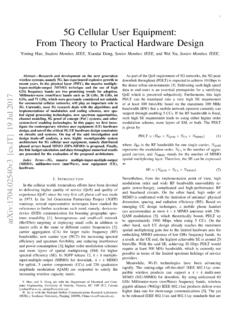Transcription of T. S. Rappaport, Y. Xing, G. R. MacCartney, Jr., A. F ...
1 T. S. Rappaport, Y. Xing, G. R. MacCartney, Jr., A. F. Molisch, E. Mellios, J. Zhang, Overview of Millimeter Wave Communications for Fifth-Generation (5G)Wireless Networks-with a focus on Propagation Models, in IEEE Transactions on Antennas and Propagation, Special Issue on 5G,Nov. 2017 Overview of Millimeter Wave Communications forFifth-Generation (5G) Wireless Networks-with a focuson Propagation ModelsTheodore S. Rappaport, Fellow,IEEE, Yunchou Xing, Student Member,IEEE, George R. MacCartney, Jr.,StudentMember,IEEE, Andreas F. Molisch,Fellow,IEEE, Evangelos Mellios,Member,IEEE, Jianhua Zhang,Senior Member,IEEE,Abstract This paper provides an overview of the features of fifthgeneration (5G) wireless communication systems now being developedfor use in the millimeter wave (mmWave) frequency bands. Early re-sults and key concepts of 5G networks are presented, and the channelmodeling efforts of many international groups for both licensed andunlicensed applications are described here.
2 Propagation parametersand channel models for understanding mmWave propagation, such asline-of-sight (LOS) probabilities, large-scale path loss, and buildingpenetration loss, as modeled by various standardization bodies, arecompared over the GHz Terms mmWave; 5G; propagation; cellular network; pathloss; channel modeling; channel model standards;I. INTRODUCTIONW ireless data traffic has been increasing at a rate of over 50%per year per subscriber, and this trend is expected to accelerateover the next decade with the continual use of video and the riseof the Internet-of-Things (IoT) [1], [2]. To address this demand, thewireless industry is moving to its fifth generation (5G) of cellulartechnology that will use millimeter wave (mmWave) frequencies tooffer unprecedented spectrum and multi-Gigabit-per-second (Gbps)data rates to a mobile device [3]. Mobile devices such as cellphones are typically referred to as user equipment (UE).
3 A simpleanalysis illustrated that 1 GHz wide channels at 28 or 73 GHzcould offer several Gbps of data rate to UE with modest phasedarray antennas at the mobile handset [4], and early work showed15 Gbps peak rates are possible with4 4phased arrays antennaat the UE and 200 m spacing between base stations (BSs) [5], [6].Promising studies such as these led the US Federal Commu-nications Commission (FCC) to authorize its 2016 SpectrumFrontiers allocation of GHz of millimeter wave spectrum for5G advancements [7], and several studies [8] [11] have proposednew mobile radio concepts to support 5G mobile S. Rappaport (email: Y. Xing (email: G. , Jr. (email: are with NYU WIRELESS ResearchCenter, and are supported in part by the NYU WIRELESS Industrial Affiliates:AT&T, CableLabs, Cablevision, Ericsson, Huawei, Intel Corporation, InterDigitalInc.)))
4 , Keysight Technologies, L3 Communications, Nokia, National Instruments,Qualcomm Technologies, SiBeam, Straight Path Communications, OPPO, Sprint,Verizon and UMC, in part by the GAANN Fellowship Program, and in part bythe National Science Foundation under Grant 1320472, Grant 1237821, and Grant1302336. NYU Tandon School of Engineering, 9th Floor, 2 MetroTech Center,Brooklyn, NY F. Molisch (email: is with the Ming Hsieh Department ofElectrical Engineering, University of Southern California, Los Angeles, CA work is supported by the National Science Foundation and Mellios (email: ), is with the CommunicationSystems & Networks Group, University of Bristol, Merchant Venturers Building,Woodland Road, BS8 1UB, Bristol, United KingdomJ. Zhang is with State Key Lab of Networkingand Switching Technology, Beijing University of Posts and Telecommunications,Mailbox , authors thank Shu Sun of NYU for her suggestions on this mmWave wireless channel bandwidths will be more thanten times greater than today s 4G Long-Term Evolution (LTE)20 MHz cellular channels.)
5 Since the wavelengths shrink by anorder of magnitude at mmWave when compared to today s 4 Gmicrowave frequencies, diffraction and material penetration willincur greater attenuation, thus elevating the importance of line-of-sight (LOS) propagation, reflection, and scattering. Accuratepropagation models are vital for the design of new mmWavesignaling protocols ( , air interfaces). Over the past few years,measurements and models for a vast array of scenarios have beenpresented by many companies and research groups [3], [4], [12] [32].This invited overview paper is organized as follows: SectionII summarizes key 5G system concepts of emerging mmWavewireless communication networks and Section III presents 5 Gpropagation challenges and antenna technologies. Section IV givesa thorough compilation and comparison of recent mmWave channelmodels developed by various groups and standard bodies, whileSection V provides concluding 5G SYSTEMCONCEPTS ANDAIRINTERFACES5G promises great flexibility to support a myriad of InternetProtocol (IP) devices, small cell architectures, and dense cov-erage areas.
6 Applications envisioned for 5G include the TactileInternet [33], vehicle-to-vehicle communication [34], vehicle-to-infrastructure communication [35], as well as peer-to-peer andmachine-to-machine communication [36], all which will requireextremely low network latency and on-call demand for large burstsof data over minuscule time epochs [37]. Current 4G LTE and WiFiroundtrip latencies are about 20-60 ms [38], [39], but 5G will offerroundtrip latencies on the order of 1 ms [40]. As shown in Fig. 1,today s 4G cellular network is evolving to support 5G, where WiFioff-loading, small cells , and distribution of wideband data will relyon servers at the edges of the network (edge servers) to enable newuse cases with lower Backhaul and FronthaulFig. 1 shows how backhaul connects the fixed cellular infras-tructure ( , BSs) to the core telephone network and the carries traffic between the local subnetwork ( , theconnections between UE and BSs) and the core network ( , theInternet and the Mobile Switching Telephone Office).
7 4G and WiFibackhaul, and not the air interface, are often sources of traffic bot-tlenecks in modern networks since backhaul connections providedby packet-based Ethernet-over-Fiber links typically provide onlyabout 1 Gbps [41], which may be easily consumed by severalUEs. In a typical macrocell site, a baseband unit (BBU) is in anenclosure at the base of a remote cell site and is directly [ ] 24 Jul 2017 Fig. 1: Mobile networks are evolving from 4G towards 5G. Shown here are small cells , edge servers, wireless backhaul, and 5G multi-tier the backhaul. The BBU processes and modulates IP packetdata from the core network into digital baseband signals wherethey are transmitted to remote radio heads (RRHs). The digitalbaseband signal travels from the BBU to a RRH via a commonpublic radio interface (CPRI) through a digital radio-over-fiber (D-RoF) connection, also known as fronthaul.
8 The RRH converts thedigital signal to analog for transmission over the air at the carrierfrequency by connecting to amplifiers and antennas to transmit thedownlink from the cell tower. The RRH also converts the receivedradio frequency (RF) uplink signal from the UEs into a digitalbaseband signal which travels from the RRH to the BBU via thesame CPRI and D-RoF connection to the base of the cell BBU then processes and packetizes the digital baseband signalfrom the RRH and sends it through a backhaul connection to thecore network. In summary, fronthaul is the connection between theRRH and BBU in both directions and backhaul is the connectionbetween the BBU and the core network in both cellular architectures support a more flexible deploy-ment of radio resources that may be distributed using a cloudradio access network technique, where a BS is split into two parts[42], one part where the RRHs are at remote cell sites, and in theother part, one centralized BBU is located up to tens of kilometersaway (see Fig.)
9 1). CPRI is used for fronthaul, and interconnectsthe centralized BBU and multiple RRHs through D-RoF. MmWavewireless backhaul and fronthaul will offer fiber-like data rates andbandwidth to infrastructure without the expense of deploying wiredbackhaul networks or long-range D-RoF [9], [43], [44].B. small CellsAn effective way to increase area spectral efficiency is to shrinkcell size [40], [45], [46] where the reduced number of users percell, caused by cell shrinking, provides more spectrum to eachuser. Total network capacity vastly increases by shrinking cells andreusing the spectrum, and future nomadic BSs and direct device-to-device connections between UEs are envisioned to emerge in5G for even greater capacity per user [47]. Femtocells that candynamically change their connection to the operator s core networkwill face challenges such as managing RF interference and keepingtiming and synchronization, and various interference avoidance andadaptive power control strategies have been suggested [45].
10 Ananalysis of the wireless backhaul traffic at GHz, 28 GHz,and 60 GHz in two typical network architectures showed thatspectral efficiency and energy efficiency increased as the number ofsmall cells increased [48], and backhaul measurements and modelsat 73 GHz were made in New York City [20], [49]. Work in[50] showed a theory for power consumption analysis, which isstrikingly similar to noise figure, for comparing energy efficiencyand power consumption in wideband networks. An early small -cellpaper [51] gave insights into enhancing user throughput, reducingsignaling overhead, and reducing dropped call Multi-tier ArchitectureThe roadmap for 5G networks will exploit a multi-tier archi-tecture of larger coverage 4G cells with an underlying network ofcloser-spaced 5G BSs as shown in Fig. 1. A multi-tier architectureallows users in different tiers to have different priorities for channelaccess and different kinds of connections ( , macrocells, smallcells, and device-to-device connections), thus supporting higherdata rates, lower latencies, optimized energy consumption, andinterference management by using resource-aware criteria for theBS association and traffic loads allocated over time and space [52].
![arXiv:0706.3639v1 [cs.AI] 25 Jun 2007](/cache/preview/4/1/3/9/3/1/4/b/thumb-4139314b93ef86b7b4c2d05ebcc88e46.jpg)

![arXiv:1301.3781v3 [cs.CL] 7 Sep 2013](/cache/preview/4/d/5/0/4/3/4/0/thumb-4d504340120163c0bdf3f4678d8d217f.jpg)
![@google.com arXiv:1609.03499v2 [cs.SD] 19 Sep 2016](/cache/preview/c/3/4/9/4/6/9/b/thumb-c349469b499107d21e221f2ac908f8b2.jpg)













